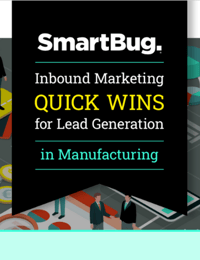
For those in the manufacturing industry, keeping up with (or staying ahead of, for that matter) the competition is not only top of mind, but it’s also a top priority. And in today’s ever-evolving landscape, the challenges that manufacturers, OEMs, and distributors deal with on a day-to-day basis have gotten even more complicated.
According to a recent Thomas study on the effects of the coronavirus, 47 percent of U.S. manufacturers report “they are now seeking domestic sources of supply.” And more than half (55 percent) also expect their revenue to decline as a result of the pandemic. Because many manufacturers are taking another look at their current operations, why not take into consideration new ways to approach marketing as well? This is where inbound marketing comes into play.
Although the manufacturing industry can be complex, the good news is that launching an inbound marketing campaign for manufacturers doesn’t have to be. There are a few simple steps that can help you get started on your way to outshining the competition and staying ahead in this competitive and changing marketplace.
Do Your Homework
You wouldn’t start building a house without building a solid foundation for it to stand on, right? The same goes with inbound marketing. Creating a solid base for your business and campaign to stand on only helps set you up for success.
1. Define Your Buyer Personas
One of the first things you’ll need to start with is understanding who your target audience and ideal customers are. To do this, you should clearly define your buyer personas. If you haven’t done so already, here’s a great tool to help you get started.
Defining your personas will help you identify not only who your buyers are but also, more importantly, what their pain points are. The more you understand about your buyers and the problems they’re looking to solve, the better the content you create for them will be. Targeting them with what they’re looking for opens huge opportunities for you to sell your products and/or services to them.
2. Get SMART
Tangible goals are a must-have when you’re launching any new initiative. Without knowing what you’re aiming toward, how will you know if you’ve succeeded or failed? This all starts with setting SMART goals. SMART is an acronym for:
- Specific
- Measurable
- Attainable
- Relevant
- Time-bound
This process will help ensure that you’re headed toward your goals, keeping you on track while giving you something to measure against. Not sure where to start? Check out these great examples.
3. Review and Assess Content
Depending on your past and current marketing efforts, you may have a lot of or too little content. Most manufacturers, OEMs, and distributors tend to focus on bottom-of-the-funnel content, which is heavily product focused and aimed at buyers who are ready to purchase.
In this phase, you will want to review and audit any existing content you may have, keeping the buyer personas you’ve developed in mind. You may find you have content that suits one persona but not others and conducting an audit will help identify any gaps or opportunities there are to use in future content development. For example, you would want to create an entirely different piece of content for an engineer than you would for a CEO. The same goes for OEMs versus distributors.
Elements of an Inbound Marketing Campaign for Manufacturers
Now that you’ve laid the groundwork to set your campaign up for success, you’ll want to start developing some great content that’s geared toward your target audience.
1. Create the Offer
Using the gap analysis or content audit that you conducted, start developing a content offer that suits your target personas. This could range from a purely educational e-book that focuses on the basics to a case study that showcases a real-life scenario in which your organization helped solve someone’s problems.
2. Develop Conversion Paths
There are four main components of a conversion path:
- Calls to action (CTAs): These are often the first touchpoint in a campaign. Use these CTAs throughout your website, blog, emails, and other high-visibility areas.
- Landing page: Once a lead clicks on a CTA, they should be taken to an optimized landing page where they can access the amazing piece of content you created. Using forms will help you gather important lead information, which you can then use for future marketing and nurturing. Make sure you’re utilizing best practices to maximize the conversion opportunities.
- Thank you page: Thank you pages are often a missed step and a lost opportunity to guide a lead further down the sales funnel. Use your thank you page as an opportunity to provide additional CTAs (secondary offers) or to find out more information about the lead.
- Follow-up email: An email should be sent that contains a link for the lead to access the offer at any time. Think about how many times you’ve found something online that you wish you had bookmarked but could’ve easily saved in your inbox if you had the opportunity.
Wondering how to keep up with all of the components of a campaign and follow-ups?
Make sure that you select the marketing automation tool that best fits your needs.
3. Show It Off
Now that you’ve developed the content and conversion elements, it’s time to focus on promoting your offer! These are, of course, things that are taken into consideration during the planning stage and when you’re setting your overall goals, but here are a few ways to execute and promote your campaign:
- Blog posts: If you haven’t already started, blogging is one of the best ways to get your content out there, not to mention the added benefits it brings, including SEO. Again, using your buyer persona information, you can create content for things that potential buyers are actually searching for to gain interest. Make sure that you’re including the CTAs you developed with relevant content.
- Social media: Making sure that you’re sharing this great content with your social media audience is a quick and effective way to get it out there. Enabling sharing features on your landing pages and emails can be as easy as a click of a button.
- Email: Use your current CRM to send emails with relevant content to your buyer personas and make sure to follow email best practices.
4. Nurture and Stay Top of Mind
Once your leads have engaged with your content, it’s important to make sure you’re nurturing them with any additional content that they may be interested in. This helps keep you top of mind and also opens up opportunities for your sales and marketing teams to follow up to get your leads closer to making a purchasing decision. There are a number of effective lead nurture strategies specifically designed for manufacturers, but a great way to start is with some evergreen strategies that can help complement your newly created content.
Test, Launch, and Analyze
Once your inbound marketing campaign is up and running, it's important to remember to test and refine it as needed. Making sure there is sales and marketing alignment is key—your sales teams can help provide some qualitative information to use in tandem with the quantitative metrics you may have decided to track during the SMART goal-setting stage.
There are many ways to create an effective inbound marketing campaign for manufacturers, and hopefully these tips will help you get started on the right track! We’ve created the Intelligent Inbound® Marketing Assessment to help show you how your current marketing efforts stack up.
About the author
Brittany Fleck is a Sr. Account Specialist based out of Hawaii. She started her career as a graphic designer and segued into creating marketing strategies for a B2B financial services company for many years. Read more articles by Brittany Fleck.








